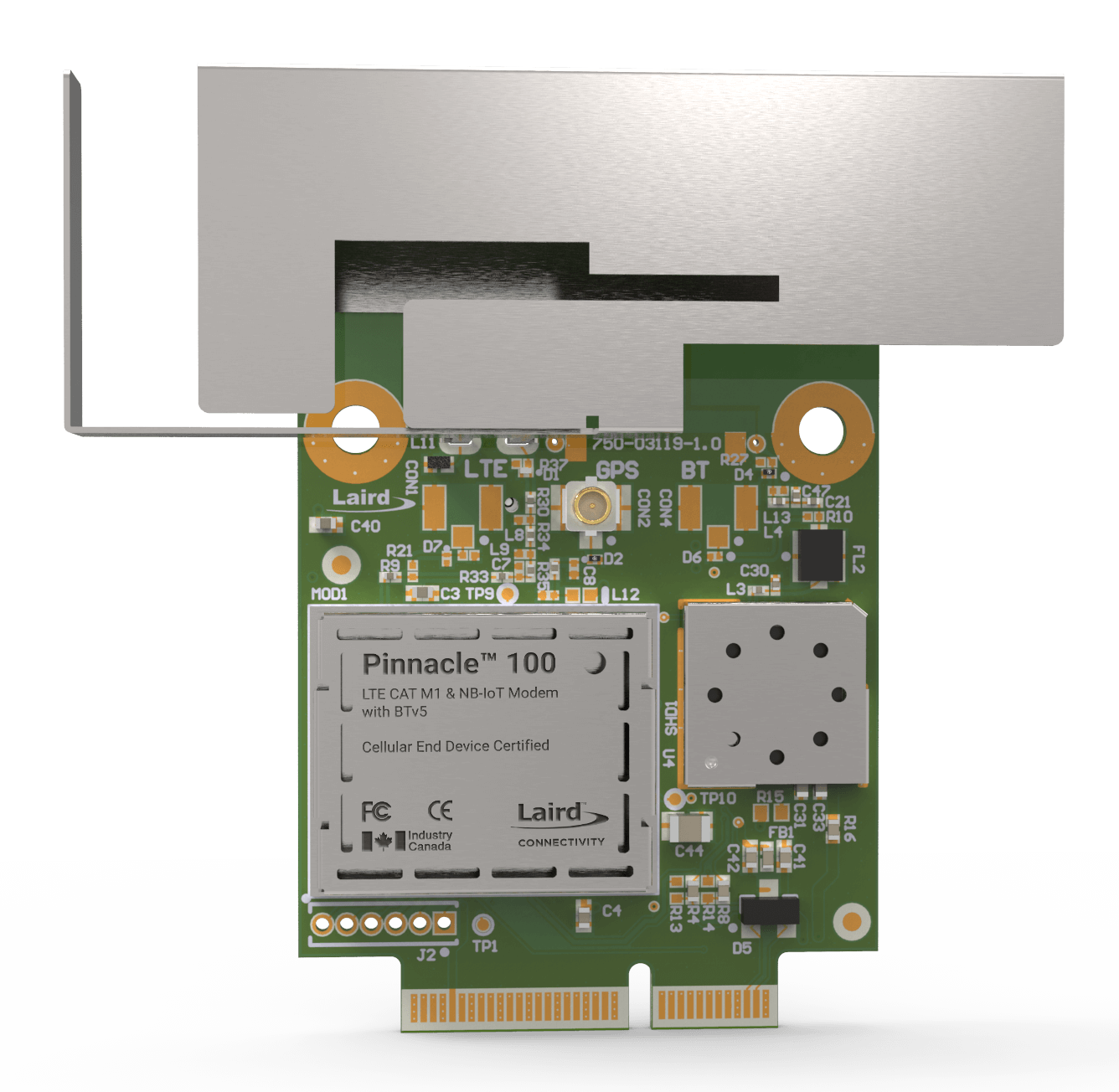Introduction
Cellular connectivity is one of the fastest-growing engineering trends in the IoT world, with good reason. The ultra-low power consumption of LTE-M and NB-IoT allows wireless devices in the field to extend battery life to ten years or more – an advantage that will appeal to engineers working on IoT implementation projects where battery life is critical. LTE-M and NB-IoT combine that extraordinary battery life with cost-effective use of wireless data. This makes them far more practical than higher throughput LTE-connected devices of the past that had high operational costs for data usage.
Those advantages of LTE-M and NB-IoT are clear, but it is important to note that cellular design can be difficult without the right plan and support. My colleague Jonathan Kaye recently wrote an excellent white paper titled Choosing the Right Route to Low-Power Cellular IoT, which serves as a primer for engineers who are new to designing cellular connectivity. As he puts it so well:
Designing cellular LTE technology is complex, and that means there are many potentially arduous routes you could take to complete your design project. Some of those routes might just add time and cost, like all unnecessary detours. Or worse, some might mean you never arrive successfully at your destination.
That white paper serves not only as an introduction to cellular IoT design, but also as a roadmap for successfully navigating potential pitfalls using best practices for technology evaluation and selection, planning for certification, early identification of your carrier of choice, antenna selection and design, design decisions that impact battery life, and more.

This white paper is essentially a Part 2 that follows Jonathan Kaye’s checklist, putting a spotlight on a key question that most engineers will face once they delve into cellular IoT projects: Should you use a module or a modem in your design?
Before comparing a modem vs. module, I’d like to start by defining the three main types of cellular hardware. The first is a chipset which is the lowest level hardware for integrating cellular into your design. A chipset is a group of integrated circuits that handles fundamental RF functions like frequency control and authentication with the cellular network. Designing from the cellular chipset level is expensive and typically only makes sense when product volumes exceed at least 250,000 so this article will focus primarily on modems and modules. A module incorporates the chipset and adds other features like a processor, memory, a place to supply power, an antenna port, and module level certifications. Some modules will also incorporate additional wireless functionality like 2G fallback and/or GPS. Modules offer a simpler way to connect to the cellular network and make sense when production volumes are above 50,000. Lastly, a modem will incorporate the module and add a range of features like more hardware interfaces, application software, hosted and hostless modes, a SIM card slot, on-board MCU, other wireless protocols like Bluetooth, and end-device certification. Modems provide the most simplified way to add cellular connectivity to a design and is ideal for getting to market quickly.
I have narrowed the discussion to this binary choice of module vs. modem because the third option, a chip down approach, is not worth exploring unless you happen to be one of the small minority of engineers who lives and breathes cellular design with product volumes in the millions. Simply put, I do not recommend a chip down approach because the complexity of cellular design is likely to send you down rabbit holes that lead to frustration, delays, and – more often than not – abandoned DIY design projects before returning to a pre-built solution like a modem or module. That isn’t a marketing message. It is hard-earned advice that any engineer would give to a peer about projects that could go off the rails. For an illustration of this point, see the Cost Justification Chart that AT&T posted on this page, which discusses how the dynamics of this decision evolve as product volume increases.
The vast majority of cellular IoT projects would greatly benefit from using a pre-designed solution that adds cellular capabilities to your design, whether it be a modem or a module. The purpose of this white paper is to map out the pros and cons of each of those options and provide advice along the way about how to successfully do what most engineers are trying to do with these projects: finish them on time, on budget, and with a design that performs the way it was intended to at the design phase.

Let’s start with four best practices that have a significant financial impact of your cellular IoT project:
1. Think about TCO Rather than Up-Front Cost
This may be one of the most important pieces of advice in this white paper because the costs involved in utilizing modems vs. modules can be dramatically different. Modems have a higher up-front cost than modules when you compare the unit cost from distributors, but the picture changes significantly when you look at the cost of the steps involved in the engineering and deployment processes. For deployments of less than 10,000 devices, the total cost of the hardware, software development, engineering work, and wireless certifications can be markedly lower for cellular modems. Cellular modules have lower up-front costs, but the time to market is slower, the engineering costs are higher, the certification processes are more arduous, and the risks are far higher in ways that may lead to delays and unexpected costs.
Let’s consider an industrial equipment manufacturer that is looking to embedded LTE-M connectivity into their machines for a predictive maintenance application. Their forecasted volumes for the coming year are 6,000 units across North America and Europe and they are under pressure to deliver this new product enhancement quickly as it will deliver significant cost savings and a competitive advantage for their end customers.
Every project is unique but this should provide a financial framework to consider when deciding between a module and modem.
Modems have a higher up-front cost than modules when you compare the unit cost from distributors, but the picture changes significantly when you look at the cost of the steps involved in the engineering and deployment processes.
2. Think Ahead to Antenna Selection and Certification
One of the most challenging aspects of cellular design is the process of antenna selection, placement and certification – all of which are impacted by the modem vs. module decision. Choosing a modem removes the need to select and certify an antenna, which eliminates the often time-consuming and costly process of integrating an antenna and securing the necessary certifications. Modems also give engineering teams the flexibility to choose internal or external antenna placement, which can have significant advantages given how the form factor of many IoT devices is often prescribed well before the antenna stage of the design process. To help simplify antenna selection, Ezurio (formerly Laird Connectivity) offers three flexible antenna options that have been certified for use with the Pinnacle 100 modem including the Revie Flex, Flex PIFA, and an external 2.4Ghz dipole antenna. In contrast, choosing a module requires the engineering team to select and certify an antenna and connect it to the module. Knowing this key point of difference will enable an engineering team anticipate what will be required once they get to the antenna stage of their project. It may also play a key role in deciding whether to choose a modem over a module.
Choosing a modem removes the need to select and certify an antenna, which eliminates the often time-consuming and costly process of integrating an antenna and securing the necessary certifications
3. Speed to market matters
For many projects, speed is the top priority for an IoT project in order to beat a competitor to market or accelerate a proof-of-concept implementation. These often tend to be lower-volume projects involving a few hundred or a few thousand devices rather than true mass quantities in the tens or hundreds of thousands. For these fast-track projects, the timeframe for designing and deploying with cellular modems is far faster for many of the reasons I outlined above. Speed is a practical reality for product engineers who need to prioritize that over other factors in order to meet the aggressive timelines for getting pilot projects launched, completing proof-of-concept tests, and moving on to the mass deployment phase. Utilizing a modem is one of the clearest ways to accelerate cellular IoT projects. I should also note that my colleagues at Ezurio have written before about best practices for accelerating design projects and those tips are well worth revisiting.
Utilizing a modem is one of the clearest ways to accelerate cellular IoT projects.
4. Certification can make or break your project
Too often, engineers think about certifications late in a project timeline, leading to unwelcome delays and costs that can impact successful completion of an IoT initiative. My rule of thumb for engineering teams is to start thinking about certifications on day one. This is particularly true for cellular IoT projects. All wireless certifications are complex, but cellular certifications have additional layers because of the need to pass through a gauntlet of certifications from industry organizations (like PTCRB and GCF), telecommunications carriers (like AT&T and Vodafone), and domestic and international authorities (like FCC and CE). The hard costs and soft costs associated with other steps in industry, carrier, and regulatory certifications are also quite high. But this can be mitigated significantly by choosing a design path that utilizes an end device certified modem that has already cleared those hurdles rather than a module that still requires them. Not only does end device certification avoid tens of thousands of dollars in test fees, compared to cellular Module certification but it reduces time to market and removes significant design risk.
Not only does end device certification avoid tens of thousands of dollars in test fees, compared to cellular Module certification but it reduces time to market and removes significant design risk.
Best Practices
Putting a focus on the previous four issues will play a major role in the success of your cellular IoT project. But there are three others best practices I would like to suggest because they will give your engineering team additional flexibility and other benefits:
Look for both variants of the cellular IoT protocols
The first piece of advice I’m giving you is the simplest: Don’t fall into the trap of thinking that there should be an either/or decision between LTE-M and NB-IoT. Other types of wireless technology force engineers to make either/or decisions early on between protocols. You should look for solutions that give you the flexibility of utilizing both on a case-by-case basis according to what a device’s role is and how it will be utilized. This is important as cellular IoT device deployments sometimes need to use both variants within the same implementation: some devices might be best suited to use the wider bandwidth, higher data transfer rate, and greater flexibility of CAT- M1. Other devices might benefit from the extended battery life that comes from NB-IoT’s more frugal use of data, narrower band, and more energy-efficient sleep cycles. Cellular IoT modems are likely to give your engineering team the most flexibility to lean on both variants as needed while utilizing the least resources for the design and provisioning stages of these projects. I should wrap up this point by saying that having both variants in a single modem can be especially important in certain international markets where only one variant may be deployed by local carriers. For example, the European market is still heavily dominated by NB-IoT with limited access to LTE-M.
Pay attention to multi-wireless support
Planning for cellular IoT deployments naturally focuses on the traditional LTE protocol vs. the low-energy NB-IoT and LTE-M protocols. But early discussions of any cellular IoT project should also put a bright spotlight on how the deployment will utilize other types of wireless connectivity such as Bluetooth for communications between devices within a network. Many modules have a narrow view of cellular IoT that only focuses on the CAT M1 and NB-IoT options; this puts the burden on product engineers to figure out how to integrate Bluetooth connectivity or other short-range, low-power protocols if required. Modems like Ezurio's Pinnacle™ 100 are designed with pre-integrated multi-technology antennas that combine both cellular and Bluetooth capability. This delivers a seamless cellular-to-Bluetooth integration that eliminates the need for complex engineering work. It also pre-empts the need for complex co-located radio certifications and has a smaller form factor than other approaches to combining cellular and Bluetooth.
Processing power may be a deciding factor
This last piece of advice I’m giving won’t apply to every project but, for certain ones, it may be a key selection criteria. For some deployments, the memory and processor that comes with a cellular modem may be a significant advantage because they provide enough computing capabilities to be a workhorse for the device’s capabilities. Cellular modems like the Pinnacle 100 come with enough memory and a large enough processor (via the Cortex M4F controller and Zephyr OS) to serve as the “brain” for some devices, allowing engineers to streamline components elsewhere in the design. This can be a major asset for reducing the form factor of a design, eliminating engineering steps, and accelerating a design project.
Ezurio's Cellular IoT Solutions:
Ezurio provides products that help simplify cellular IoT for product engineers. The flagship product of Ezurio's cellular IoT line is the Pinnacle™ 100.
The Pinnacle 100 cellular modem makes it simple for product engineers to design and deploy IoT devices that incorporate both low-power cellular and Bluetooth capabilities. The Pinnacle 100 modem seamlessly incorporates a powerful Cortex M4F controller, full Bluetooth v5, and LTE-M/NB-IoT capabilities – all with full regulatory certifications and LTE carrier approvals. This helps avoid any limitations of a single wireless option, making for an easier global market deployment. The Pinnacle 100 provides the easiest way to deliver wireless Bluetooth v5 sensor data to the cloud via services like AWS IoT over a low-power LTE connection. It is also the only cellular solution on the market to have a pre-integrated embedded antenna, as well as giving the option for external antenna use. This feature allows for greater flexibility and a less complex approach to selecting an antenna option.
Engineers can develop their applications directly on the M4F controller using Zephyr RTOS to cut BOM costs and power consumption. Extremely power conscious, the Pinnacle 100 is ideal for battery-powered devices operating at the edge of IoT networks, seamlessly bridging the cellular WAN to the Bluetooth PAN. Its ability to bridge these two makes the product supportive in more use cases and application architectures than standalone Bluetooth and cellular modules.

About the Author
Matt Stergiou is the Senior Product Manager for IoT at Ezurio Solutions which provides a full range of embedded wireless modules and other solutions that simplify the process of using wireless technology. In his role at the company, Stergiou oversees development of a range of IoT solutions that support wireless deployments in a range of vertical industries. Prior to Ezurio, he held positions at Bell working on cellular IoT. He earned his degrees at the University of Toronto.

 Laird Connectivity is now Ezurio
Laird Connectivity is now Ezurio